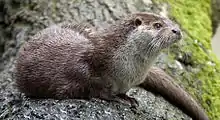List of mammals of San Marino
This is a list of the mammal species recorded in San Marino. There are nine mammal species in San Marino, of which one is near threatened.[1]
The following tags are used to highlight each species' conservation status as assessed by the International Union for Conservation of Nature:
| EX | Extinct | No reasonable doubt that the last individual has died. |
| EW | Extinct in the wild | Known only to survive in captivity or as a naturalized populations well outside its previous range. |
| CR | Critically endangered | The species is in imminent risk of extinction in the wild. |
| EN | Endangered | The species is facing an extremely high risk of extinction in the wild. |
| VU | Vulnerable | The species is facing a high risk of extinction in the wild. |
| NT | Near threatened | The species does not meet any of the criteria that would categorise it as risking extinction but it is likely to do so in the future. |
| LC | Least concern | There are no current identifiable risks to the species. |
| DD | Data deficient | There is inadequate information to make an assessment of the risks to this species. |
Some species were assessed using an earlier set of criteria. Species assessed using this system have the following instead of near threatened and least concern categories:
| LR/cd | Lower risk/conservation dependent | Species which were the focus of conservation programmes and may have moved into a higher risk category if that programme was discontinued. |
| LR/nt | Lower risk/near threatened | Species which are close to being classified as vulnerable but are not the subject of conservation programmes. |
| LR/lc | Lower risk/least concern | Species for which there are no identifiable risks. |
Order: Rodentia (rodents)
Rodents make up the largest order of mammals, with over 40% of mammalian species. They have two incisors in the upper and lower jaw which grow continually and must be kept short by gnawing. Most rodents are small though the capybara can weigh up to 45 kg (99 lb).
- Suborder: Myomorpha
- Family: Cricetidae
- Subfamily: Arvicolinae
- Genus: Myodes
- Bank vole, Myodes glareolus LR/lc
- Genus: Myodes
- Subfamily: Arvicolinae
- Family: Muridae (mice, rats, gerbils, etc.)
- Subfamily: Murinae
- Genus: Apodemus
- Wood mouse, Apodemus sylvaticus LC
- Genus: Apodemus
- Subfamily: Murinae
- Family: Cricetidae
Order: Soricomorpha (shrews, moles, and solenodons)
The "shrew-forms" are insectivorous mammals. The shrews and solenodons closely resemble mice while the moles are stout-bodied burrowers.
- Family: Talpidae (moles)
- Subfamily: Talpinae
- Tribe: Talpini
- Genus: Talpa
- Blind mole, T. caeca LC
- Genus: Talpa
- Tribe: Talpini
- Subfamily: Talpinae
Order: Chiroptera (bats)
The bats' most distinguishing feature is that their forelimbs are developed as wings, making them the only mammals capable of flight. Bat species account for about 20% of all mammals.
- Family: Vespertilionidae
- Subfamily: Miniopterinae
- Genus: Miniopterus
- Schreibers' long-fingered bat, Miniopterus schreibersii LC
- Genus: Miniopterus
- Subfamily: Miniopterinae
- Family: Rhinolophidae
- Subfamily: Rhinolophinae
- Genus: Rhinolophus
- Greater horseshoe bat, Rhinolophus ferrumequinum LR/nt
- Lesser horseshoe bat, Rhinolophus hipposideros LC
- Genus: Rhinolophus
- Subfamily: Rhinolophinae
Order: Carnivora (carnivorans)

There are over 260 species of carnivorans, the majority of which feed primarily on meat. They have a characteristic skull shape and dentition.
- Suborder: Caniformia
- Family: Canidae (dogs, foxes)
- Family: Mustelidae (mustelids)
- Genus: Mustela
- Least weasel, Mustela nivalis LR/lc
- Genus: Lutra
- European otter, Lutra lutra NT
- Genus: Mustela
See also
Notes
- This list is derived from the IUCN Red List which lists species of mammals and includes those mammals that have recently been classified as extinct (since 1500 AD). The taxonomy and naming of the individual species is based on those used in existing Wikipedia articles as of 21 May 2007 and supplemented by the common names and taxonomy from the IUCN, Smithsonian Institution, or University of Michigan where no Wikipedia article was available.
References
- "The IUCN Red List of Threatened Species: Mammals of San Marino". IUCN. 2001. Retrieved 22 May 2007.
- "Mammal Species of the World". Smithsonian National Museum of Natural History. 2005. Archived from the original on 27 April 2007. Retrieved 22 May 2007.
- "Animal Diversity Web". University of Michigan Museum of Zoology. 1995–2006. Retrieved 22 May 2007.